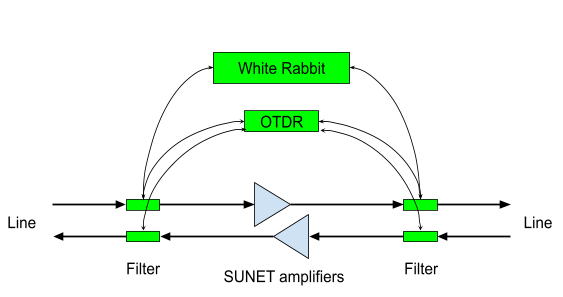
What is White Rabbit and why does it matter for high accuracy time services?
In this Q&A, we discuss the benefits and challenges of deploying White Rabbit and the steps Netnod has taken to achieve sub-nanosecond accuracy.
1. What is White Rabbit?
While many time services today rely on the Global Navigation Satellite Systems (GNSS), such as GPS, Glonass, Galileo and Beidou, GNSS can have serious issues. These include signal interference, unpredictable latency and vulnerability to attack using signal jamming and spoofing. Precision Time Protocol (PTP) services connected to atomic clocks were designed to provide an alternative form of high accuracy synchronisation. But PTP has accuracy issues over long distances which means that the further a network node is from a master clock the less certain you can be that high accuracy can be maintained.
White Rabbit was developed to fix this and to enable Ethernet networks to achieve sub-nanosecond accuracy over a large area. When fully developed, a White Rabbit implementation enables networks to run tens of thousands of nodes all based on the same master clock. By enabling any Ethernet network to achieve sub-nanosecond accuracy, White Rabbit has significant value for a range of commercial sectors including telecommunications, Financial Services, Smart Grids and Air Traffic Management.
Originally developed at CERN to synchronise the measurement and control equipment of particle accelerators and detectors, White Rabbit builds on the PTP / IEEE 1588 and SyncE (Synchronous Ethernet) standards, which are currently the most advanced standards for high accuracy time synchronisation.
White Rabbit is flexible enough to be used for pretty much any time transfer application that needs to work over some distance. Apart from being used in larger physics labs, it is increasingly used in time labs and commercial sectors to ensure sub-nanosecond accuracy.
2. Why is such sub-nanosecond accuracy important?
When running a high performance time dissemination system such as the one operated by Netnod, being able to compare time between the different parts of the system with high accuracy is key.
Today the most common applications using this level of accuracy are related to particle accelerators, radio telescopes and such. It is likely we will see more applications for high accuracy time. For example, there are currently discussions about cellular networks and what could be done with higher time accuracy than they use today. This includes developing high accuracy positioning services, even more advanced radio protocols, more advanced steering of the radio lobes, and other ways to make new or improved services as well as to optimise radio bandwidth usage.
3. How is White Rabbit different to other technologies?
GNSS-based services such as GPS, Glonass, Galileo and Beidou, all provide good time for a very low cost. But they are also very fragile. For example, they are easy to jam and can be spoofed. They also don’t work indoors and are reliant on a third party for transfer.
While a normal PTP service provides a level of time accuracy sufficient for most current use cases, White Rabbit compensates for the chromatic dispersion of the fibre. This can be an issue for long distance fibre connections between a master atomic clock and different nodes of a network.
White Rabbit is designed to enable PTP time services to maintain sub-nanosecond accuracy even over long distances. It is an open standard, has open source software and hardware designs, and runs on hardware available from multiple vendors. White Rabbit is now also part of the new PTP standard, IEEE 1588-2019, as the HA, High Accuracy, profile. This will most likely mean that even more vendors will build White Rabbit equipment giving us and our customers more choice, and probably resulting in lower prices.
There are other high accuracy alternatives, but they are proprietary and very expensive. For applications where high accuracy time is to be distributed on a larger scale than individual links, it seems everyone today is looking at White Rabbit / PTP-HA. It is especially applicable for big networks that need high accuracy synchronisation. But there are a series of deployment issues that need to be resolved before a White Rabbit service is production-ready.
4. What has Netnod done with White Rabbit so far?
We have evaluated a range of different equipment testing and adapting it to work in parallel with the equipment the Swedish National Research and Educational Network, SUNET, uses on the same fibre links.
We use bi-directional transmission, which increases accuracy as it guarantees that the cable has the same length in both directions. While this means we do not get time errors because of length asymmetries, it does mean that we cannot use reconfigurable add-drop-multiplexers (ROADMs), unidirecional amplifiers, and all the other good things that are already in an optical network such as SUNET’s. Instead, we need to run in wavelengths on the side of SUNET’s Dense Wavelength Division Multiplexing (DWDM) equipment, and use separate amplifiers (see figure 1). This meant that we had to work with suppliers to get custom built wavelength filters and optical interfaces (SFPs).

Figure 1: White Rabbit and a DWDM network
We used this setup to build a high accuracy fibre link between two of our time nodes in Stockholm and Sundsvall over a distance of about 440 km. We saw a far better performance than using a fibre link based on traditional PTP and without bidirectional transmission.
We also automated many of the processes used for the different kinds of calibrations which are cumbersome, time consuming and prone to error when done manually. We set up a calibration rig with instruments and cabling, used fibre switches to automate switching between different fibre links, and automated the communication and calculations. With this level of automation, we can do each measurement several times and can calibrate iteratively to achieve even better accuracy.
5. What issues did Netnod have to solve to implement White Rabbit successfully?
We evaluated several White Rabbit boxes to find one which is reasonably reliable and flexible. To get our signal on the fibre, we had to order custom wavelength division multiplexing (WDM) filters to multiplex it in with the SUNET traffic. As SUNET also wanted to install Optical Time Domain Reflectometers (OTDRs) for fault prediction and finding, we had the filters made to provide for OTDRs by inserting a third wavelength window.
We needed to ensure high wavelength stability as wavelength drift would affect the time transfer of the link. But as we also needed to use a non-standard wavelength, this meant that we had to order custom transceivers (known as small form-factor pluggables or SFPs). There were not a lot of vendors that were willing to do that for a small test series. There were manufacturing problems for some wavelengths where the yield for the lasers was not satisfactory.
6. What’s coming next with White Rabbit?
The fact that White Rabbit is now part of the PTP standard as the High Accuracy (HA) profile will likely have important consequences.
Today, White Rabbit switches and network interfaces (NICs) are implemented in FPGA (Field Programmable Gate Array), a special type of chip where the logic can be reprogrammed at any time. However, FPGA chips are more expensive and slower than application-specific integrated circuit (ASIC) chips made with a single and set function that are most often used today for ordinary switches, CPUs, network interfaces, memory, and other things. This means that currently to get the time accuracy needed for White Rabbit, special switches and network interfaces must be used.
This should change as we will likely soon see support for PTP HA in standard Ethernet switch and network interfaces in the same way that ordinary PTP, without HA, is supported by default in much of the network equipment today.
There is also a need for more standardisation on the optical side for bidirectional transmission on long distance fibre. We will likely see more of that too as the demand for high accuracy time increases, it will simplify usage quite a bit when you do not have to order custom built wavelength filters and optical interfaces (e.g. SFPs) as was necessary for our implementation.
More information
PTP is used by industries ranging from banking and financial services to telecommunications, transport and the energy sector. Netnod provides PTP services from multiple nodes throughout Sweden. For any organisation that needs to ensure the highest level of time accuracy, Netnod’s PTP service enables you to:
- Time stamp with the highest degree of accuracy
- Receive traceable time over a dedicated fibre
- Achieve redundancy for mission-critical services that use GNSS
You can find information about PTP, and contact our time experts here.
Netnod also provides a freely available Network Time Protocol (NTP) service which was one of the first in the world to offer Network Time Security (NTS). Netnod has played a leading role in developing the new standard and implementations for NTS.
More information about Netnod’s time and frequency services is available here.
Netnod provides robust and traceable time and frequency services on behalf of the Swedish Post and Telecom Authority to make Sweden more resilient and better equipped for the future.
Ragnar “Ragge” Sundblad
Ragge works with the time dissemination system at Netnod, and has developed most of the inner workings of the Netnod time nodes as they run today. He was also in the team behind the Network Time Security (NTS) standard RFC 8915 for securing time distribution over the Internet.




